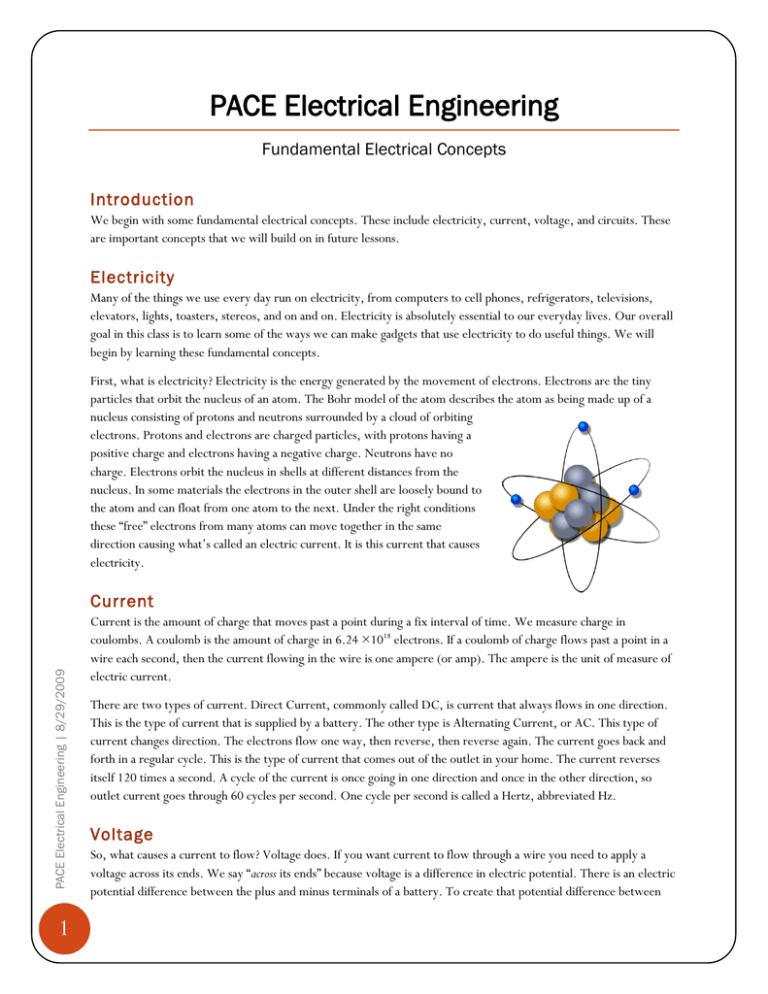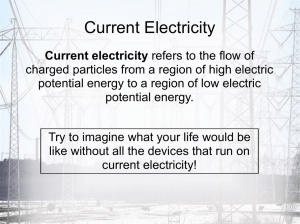Fundamental Electrical Concepts
advertisement

PACE Electrical Engineering Fundamental Electrical Concepts Introduction We begin with some fundamental electrical concepts. These include electricity, current, voltage, and circuits. These are important concepts that we will build on in future lessons. Electricity Many of the things we use every day run on electricity, from computers to cell phones, refrigerators, televisions, elevators, lights, toasters, stereos, and on and on. Electricity is absolutely essential to our everyday lives. Our overall goal in this class is to learn some of the ways we can make gadgets that use electricity to do useful things. We will begin by learning these fundamental concepts. First, what is electricity? Electricity is the energy generated by the movement of electrons. Electrons are the tiny particles that orbit the nucleus of an atom. The Bohr model of the atom describes the atom as being made up of a nucleus consisting of protons and neutrons surrounded by a cloud of orbiting electrons. Protons and electrons are charged particles, with protons having a positive charge and electrons having a negative charge. Neutrons have no charge. Electrons orbit the nucleus in shells at different distances from the nucleus. In some materials the electrons in the outer shell are loosely bound to the atom and can float from one atom to the next. Under the right conditions these “free” electrons from many atoms can move together in the same direction causing what’s called an electric current. It is this current that causes electricity. PACE Electrical Engineering | 8/29/2009 Current 1 Current is the amount of charge that moves past a point during a fix interval of time. We measure charge in coulombs. A coulomb is the amount of charge in 6.24 ×1018 electrons. If a coulomb of charge flows past a point in a wire each second, then the current flowing in the wire is one ampere (or amp). The ampere is the unit of measure of electric current. There are two types of current. Direct Current, commonly called DC, is current that always flows in one direction. This is the type of current that is supplied by a battery. The other type is Alternating Current, or AC. This type of current changes direction. The electrons flow one way, then reverse, then reverse again. The current goes back and forth in a regular cycle. This is the type of current that comes out of the outlet in your home. The current reverses itself 120 times a second. A cycle of the current is once going in one direction and once in the other direction, so outlet current goes through 60 cycles per second. One cycle per second is called a Hertz, abbreviated Hz. Voltage So, what causes a current to flow? Voltage does. If you want current to flow through a wire you need to apply a voltage across its ends. We say “across its ends” because voltage is a difference in electric potential. There is an electric potential difference between the plus and minus terminals of a battery. To create that potential difference between the ends of the wire, you need to connect one end to the positive battery terminal and the other end to the negative terminal. This idea of electric potential difference is similar to the idea of the difference in potential energy between a ball on the ground and a ball held four feet above the ground. If you let go of the ball on the ground, nothing happens. If you let go of the ball four feet above the ground it falls. The potential energy of that ball held in the air is equal to the kinetic energy (energy of motion) of the ball once it is released. Voltage is measured in volts. Resistance Resistance describes a material’s ability to resist the flow of current. It is measured in ohms. Resistance is used in a circuit to control the current through an element, which can protect it from burning out. It can also control the voltage across an element. Ohm’s Law There is a mathematical relationship between voltage (V), current (I), and resistance (R). This relationship is called Ohm’s Law. Ohm’s Law is as follows: V = IR where V is the voltage across a circuit element, I is the current through the element, and R is the resistance of the element. In addition, V, I, and R must be measured in compatible units. For example, if you + V were given I in amps and R in ohms and wanted to find V, you could plug the numbers into R the equation and the answer would be in volts. If, on the other hand, R were given in kiloI ohms, the answer would not be in volts. You would have to convert the resistance from kiloohms to ohms first. Circuits This same circuit can be represented by a diagram, where each element is represented by a symbol and wires are represented by lines. Circuit diagrams are a pictorial representation of a circuit that can be used to analyze or build a circuit. The diagram shows each of the elements of the circuit and how they are connected to each other. For some elements, it will show the value of a characteristic property. For example, it will show the resistance of a resistor or PACE Electrical Engineering | 8/29/2009 A circuit is an interconnection of electrical components. An example of a simple electric circuit consists of a battery a switch and a light bulb. If you connect them all together and close the switch, the light shines. 2 PACE Electrical Engineering | 8/29/2009 the voltage of a battery. For other elements it will show the type or model of the element. For example, a transistor will be labeled with its type such as a 2N3904 or a 2N2222. This lets you know which transistor to use in building the circuit. 3




